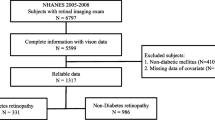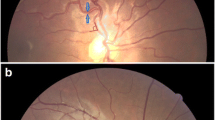Abstract
Aims
To compare the annual axial length (AL) changes in myopic children with type 1 diabetes mellitus (T1DM) and those without diabetes.
Methods
There are two groups of myopic children in this retrospective cohort study. Group 1 consisted of myopic children with T1DM (44 eyes of 22 patients). Group 2 comprised age-matched myopic children without diabetes (44 eyes of 22 children). These two groups were compared with regard to their baseline clinical characteristics. A generalized estimating equations (GEE) model was also used to determine the most likely factor that contributed to the results.
Results
The average ages of group 1 and group 2 were 14.8 and 14.6 years, respectively. Children in group 1 had significantly slower annual AL changes (0.051 mm/year vs 0.103 mm/year; 50.5% slower, P = 0.011) and shorter baseline AL (23.97 vs 25.19 mm, P < 0.001) than those in group 2. GEE also showed that serum glycated hemoglobin (HbA1c) level (B = −0.023, P = 0.039) was the most important factor in reducing AL elongation in group 1 myopic children.
Conclusions
Long-term higher HbA1c level may reduce AL elongation. A strict blood sugar control strategy in clinical practice is warranted to axial myopia progression in T1DM children.

Similar content being viewed by others
Data availability
The datasets analyzed during the current study are available from the corresponding author on reasonable request.
Change history
13 April 2021
A Correction to this paper has been published: https://doi.org/10.1007/s00592-021-01695-w
References
Kojic Damjanov S, Deric M, Eremic Kojic N (2014) Glycated hemoglobin A1c as a modern biochemical marker of glucose regulation. Medicinski pregled 67(9–10):339–344
Nathan DM, Genuth S, Lachin J et al (1993) The effect of intensive treatment of diabetes on the development and progression of long-term complications in insulin-dependent diabetes mellitus. N Engl J Med 329(14):977–986. https://doi.org/10.1056/nejm199309303291401
James S, Gallagher R, Dunbabin J, Perry L (2014) Prevalence of vascular complications and factors predictive of their development in young adults with type 1 diabetes: systematic literature review. BMC research notes 7:593. https://doi.org/10.1186/1756-0500-7-593
Kang EY, Lo FS, Wang JP et al (2018) Nomogram for prediction of non-proliferative diabetic retinopathy in juvenile-onset type 1 diabetes: a cohort study in an Asian population. Sci rep 8(1):12164. https://doi.org/10.1038/s41598-018-30521-7
Wolffsohn JS, Flitcroft DI, Gifford KL et al (2019a) IMI - myopia control reports overview and introduction. Invest Ophthalmol Vis Sci 60(3):M1-m19. https://doi.org/10.1167/iovs.18-25980
Gifford KL, Richdale K, Kang P et al (2019) IMI - clinical management guidelines report. Invest Ophthalmol Vis Sci 60(3):M184-m203. https://doi.org/10.1167/iovs.18-25977
Hou W, Norton TT, Hyman L, Gwiazda J (2018) Axial elongation in myopic children and its association with myopia progression in the correction of myopia evaluation trial. Eye and contact lens 44(4):248–259. https://doi.org/10.1097/icl.0000000000000505
Wolffsohn JS, Kollbaum PS, Berntsen DA et al (2019b) IMI - clinical myopia control trials and instrumentation report. Invest Ophthalmol Vis Sci 60(3):M132-m160. https://doi.org/10.1167/iovs.18-25955
Wu PC, Chuang MN, Choi J et al (2019) Update in myopia and treatment strategy of atropine use in myopia control. Eye 33(1):3–13. https://doi.org/10.1038/s41433-018-0139-7
Wildsoet CF, Chia A, Cho P et al (2019) IMI - interventions myopia institute: interventions for controlling myopia onset and progression report. Invest Ophthalmol Vis Sci 60(3):M106-m131. https://doi.org/10.1167/iovs.18-25958
Carkeet A, Saw SM, Gazzard G, Tang W, Tan DT (2004) Repeatability of IOLMaster biometry in children. Optom vis sci: off publ Am Acad Optom 81(11):829–834
Tideman JW, Snabel MC, Tedja MS et al (2016) Association of axial length with risk of uncorrectable visual impairment for Europeans with myopia. JAMA ophthalmol 134(12):1355–1363. https://doi.org/10.1001/jamaophthalmol.2016.4009
Gwinup G, Villarreal A (1976) Relationship of serum glucose concentration to changes in refraction. Diabetes 25(1):29–31. https://doi.org/10.2337/diab.25.1.29
Mantyjarvi M (1988) Myopia and diabetes a review. Acta Ophthalmol Suppl 185:82–85. https://doi.org/10.1111/j.1755-3768.1988.tb02672.x
Logstrup N, Sjolie AK, Kyvik KO, Green A (1997) Long-term influence of insulin dependent diabetes mellitus on refraction and its components: a population based twin study. Br j ophthalmol 81(5):343–349
Cordain L, Eaton SB, Brand Miller J, Lindeberg S, Jensen C (2002) An evolutionary analysis of the aetiology and pathogenesis of juvenile-onset myopia. Acta ophthalmologica Scandinavica 80(2):125–135
Jacobsen N, Jensen H, Lund-Andersen H, Goldschmidt E (2008) Is poor glycaemic control in diabetic patients a risk factor of myopia? Acta Ophthalmol 86(5):510–514. https://doi.org/10.1111/j.1600-0420.2007.01104.x
Wiemer NG, Dubbelman M, Hermans EA, Ringens PJ, Polak BC (2008) Changes in the internal structure of the human crystalline lens with diabetes mellitus type 1 and type 2. Ophthalmol 115(11):2017–2023. https://doi.org/10.1016/j.ophtha.2008.06.032
Wiemer NG, Dubbelman M, Kostense PJ, Ringens PJ, Polak BC (2008) The influence of diabetes mellitus type 1 and 2 on the thickness, shape, and equivalent refractive index of the human crystalline lens. Ophthalmol 115(10):1679–1686. https://doi.org/10.1016/j.ophtha.2008.03.019
Sjolie AK, Mortensen KK, Hecht PS, Eshoj O (1991) Visual acuity and refraction in type I diabetic patients aged 25–34 years. Acta ophthalmologica 69(4):552–554
Johansen J, Sjolie AK, Eshoj O (1994) Refraction and retinopathy in diabetic children below 16 years of age. Acta ophthalmologica 72(6):674–677
Handa S, Chia A, Htoon HM, Lam PM, Yap F, Ling Y (2015) Myopia in young patients with type 1 diabetes mellitus. Singapore Med J 56(8):450–454. https://doi.org/10.11622/smedj.2015122
Wang NK, Lai CC, Wang JP et al (2016) Risk factors associated with the development of retinopathy 10 yr after the diagnosis of juvenile-onset type 1 diabetes in Taiwan: a cohort study from the CGJDES. Pediatr Diabetes 17(6):407–416. https://doi.org/10.1111/pedi.12312
Huang J, Wen D, Wang Q et al (2016) Efficacy Comparison of 16 Interventions for myopia control in children: a network meta-analysis. Ophthalmol 123(4):697–708. https://doi.org/10.1016/j.ophtha.2015.11.010
Herse P (2005) Effects of hyperglycaemia on ocular development in rabbit: refraction and biometric changes. Ophthalmic physio opt: j Br Coll of Ophthalmic Opticians (Optometrists) 25(2):97–104. https://doi.org/10.1111/j.1475-1313.2004.00262.x
American Diabetes A (2018) Children and adolescents: standards of medical care in diabetes-2018. Diabetes Care. https://doi.org/10.2337/dc18-S012
Ganesan P, Wildsoet CF (2010) Pharmaceutical intervention for myopia control. Expert Rev Ophthalmol 5(6):759–787. https://doi.org/10.1586/eop.10.67
Galvis V, Lopez-Jaramillo P, Tello A et al (2016) Is myopia another clinical manifestation of insulin resistance? Med Hypotheses 90:32–40. https://doi.org/10.1016/j.mehy.2016.02.006
Le Roith D 1997 Seminars in medicine of the Beth Israel deaconess medical center. Insulin-like growth factors. New Engl J Med 336(9): 633-640 doi:10.1056/nejm199702273360907
Nambam B, Schatz D (2018) Growth hormone and insulin-like growth factor-I axis in type 1 diabetes. Growth Horm IGF Res 38:49–52. https://doi.org/10.1016/j.ghir.2017.12.005
Lin H, Lin D, Chen J et al (2016) Distribution of axial length before cataract surgery in chinese pediatric patients. Sci rep 6:23862. https://doi.org/10.1038/srep23862
Acknowledgements
The authors thank the Bio-Statistical Consultation Center of Chang Gung Memorial Hospital, Keelung, Taiwan for professional manuscript preparation advice.
Funding
Chun-Fu Liu was supported by the research grant CMRPG 2I0131 from Chang Gung Memorial Hospital, Keelung, Taiwan. Eugene Yu-Chuan Kang and Chi-Chun Lai were supported by the research grant CMRPG 3K0481 from Chang Gung Memorial Hospital, Linkou, Taiwan. Nan-Kai Wang was supported by the research grant R01EY031354 from National Eye Institute, United State of America. The funder had no role in study design, data collection and analysis, decision to publish, or preparation of the manuscript.
Author information
Authors and Affiliations
Contributions
Chun-Fu Liu, Shin-Chieh Chen, Fu-Sung Lo and Nan-Kai Wang contributed to the study conception and design. All authors performed material preparation and data collection. Chun-Fu Liu and Shin-Chieh Chen performed data analysis, interpretation and wrote the first draft of the manuscript. All authors read and approved the final manuscript.
Corresponding authors
Ethics declarations
Conflict of interest
The authors declare that they have no conflict of interest.
Ethics approval
This study was reviewed and approved by the institutional review board of Chang Gung Memorial Hospital. Approval Number: 202001771B0.
Informed consent
No informed consent was obtained as this study analyzed de-identified participant data for which formal consent is not required. The study protocol and a waiver for consent to participation were approved by the Institutional Review Board of Chang Gung Memorial Hospital (Approval No.: 202001771B0) and followed the tenets of the Declaration of Helsinki.
Additional information
Publisher's Note
Springer Nature remains neutral with regard to jurisdictional claims in published maps and institutional affiliations.
This article belongs to the topical collection Eye Complications of Diabetes, managed by Giuseppe Querques.
The original online version of this article was revised: The correct version of the Supplementary Table 1 is updated.
Electronic supplementary material
Below is the link to the electronic supplementary material.
Rights and permissions
About this article
Cite this article
Liu, CF., Chen, SC., Chen, KJ. et al. Higher HbA1c may reduce axial length elongation in myopic children: a comparison cohort study. Acta Diabetol 58, 779–786 (2021). https://doi.org/10.1007/s00592-020-01631-4
Received:
Accepted:
Published:
Issue Date:
DOI: https://doi.org/10.1007/s00592-020-01631-4




